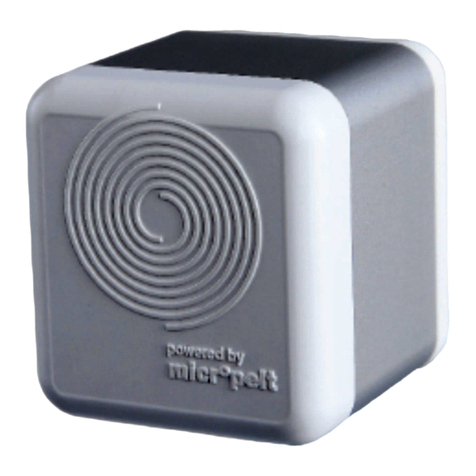
MVA008 General description – 6
4 MVA008 General description
This document defines the properties of Micropelt’s battery free thermostatic radiator valve MVA008. The unit is directly
mounted onto radiator valve bodies (M30x1,5 thread or Valve adapter ), where it controls the room temperature, based on
signals of a central controller. It is radio-controlled and powered by energy harvesting, so it neither requires any cabling work
nor does it consume batteries. It is designed for maintenance-free operation. The wireless design makes the unit ideal for retrofit
installation and cost-sensitive projects, where cabling cost is prohibitive. A room controller can be used to conveniently set time
programs that set the room temperature to different values at different times of the day. By lowering the room temperature in
times of absence, heating costs can be saved without any loss of comfort. Reducing the room temperature by just a few ° C also
leads to cost savings.
The actuator generates the energy required for operation (engine running, sensors and radio communication) by means of a
built-in thermoelectric generator (TEG) and is therefore maintenance-free. This is supplied from the temperature difference
between the radiator heat and the ambient temperature (usually the room temperature). An additional source of energy, such as
a battery or a mains connection is not required. The internal energy storage is pre-charged upon delivery. This means that
sufficient energy is available for the installation and approximately one year of normal operation. The internal storage unit is
recharged through excess energy generated during heating operation, which means that sufficient energy is available for year-
round operation.
At its user interface, MVA008 has a red and a green LED. Two internal temperature sensors are used with its internal temperature
controller and freeze protection (ambient sensor) and the automatic radio duty cycle control of 2, 5 or 10 minutes (flow
temperature sensor).
MVA008 is operating with EnOcean standard EEP A5-20-01 (4BS) in either valve position or set temperature mode. According to
the standard protocol, the unit reports to the room controller every 2/5 or 10 minutes (auto radio interval) transmitting its
current valve position and status information. The room controller responds with either a new control value in the value range
0% (valve closed) to 100% (valve maximum open) or setpoint temperature (0 ... 40 ° C). When the setpoint changes, the actuator
motor moves the motor to the new position. When operating with the setpoint temperature, we recommend to use a separate,
external room temperature sensor that transmits its temperature to the room controller, which forwards it to the MVA004 as part
of the A5-20-01 protocol. By heat input from the radiator in the unit, there are deviations between the measured and actual room
temperature, which are compensated by means of an integrated correction function. The first 30 minutes after activation are
used to calibrate the offset compensated ambient temperature value. During that time, the valve will transmit its internal and
fixed temperature value of 20°C and then automatically switch over to the corrected value.
The actuator is delivered in mounting position (motor position is fully retracted). The actuator has an internal valve recognition
(ACO). In addition to a blockage, the ACO bit also signals any unsuccessfully completed reference run and when starting from
mounting position. A dynamic zero-point correction ensures that the valve closes in the long term. Unmounted but activated will
automatically move the motor back to mounting position to switch-off the device.
In the event of a radio failure (6 unsuccessful communication attempts), the internal temperature controller is activated, and the
radiator is regulated to a preset 21 ° C. A change of the radio interval does not take place. The drive goes into normal operation
as soon as the radio communication is restored.
When operating in unheated rooms, the internal storage will be discharged. The unit then moves to 50% open position trying to
recharge its storage. Operation in little or unheated rooms must be avoided since normal operation can not be guaranteed and a
manual battery recharging is needed.
MVA008 is designed for low power operation. Therefore, all ReMan and ReCom operations are internally time limited and must
be executed within less than 8 seconds. It is strongly recommended to execute ReMan only for initial teach over the air (Link
Table) and device configuration (RESET) following its initial deployment.
MVA008 has a button lock after one-hour function integrated that will prevent from unintended use.




























